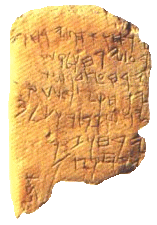Description: This inscription, discovered in the Ancient city of Gezer, chronicles the different growing seasons of the different months and is therefore known as the Gezer Calender.
Era: Middle Semitic Script
Image Credit: Jona Lendering
Date of Inscription: c. 900 BCE
Location of Discovery: Tell El-Jazari (Ancient Gezer), Israel
Date of Discovery: 1908
Current Location: Museum of the Ancient Orient, a Turkish archaeology museum. A replica of the Gezer calendar is on display at the Israel Museum, Israel.
Language: Hebrew
Writing Surface: Limestone
Inscription: ירחואספ ירחוז
רע ירחולקש
ירחעצדפשת
ירחקצרשערמ
ירחקצרוכל
ירחוזמר
ירחקצ
(אבי(ה
Transliteration: 1. YRHhW ASP YRHhW Z(RAh)
2. RAh YRHhW LQSh
3. YRHh AhTsD PShT
4. YRHh QTsR ShAhRM
5. YRHh QTsR WKL
6. YRHhW ZMR
7. YRHh QTs
8. ABYH (lower left corner, top to bottom)
Translation: 1. Two months are harvest Two months are planting
2. Two months are late (planting)
3. One month is hoeing flax
4. One month is barley-harvest
5. One month is harvest and feasting
6. Two months are pruning
7. One month is summer fruit
8. Abiyah (The scribe of the inscription)
(Translation by Jeff A. Benner)
Comments: The inscription on the calendar describes the bi-monthly periods and attributes to each a duty such as harvest, planting, or tending specific crops. The scribe of the calendar is probably "Abiyah", which means "Yah is my father". This name appears in the Bible for several individuals, including a king of Judah (1 Kings 14:31).



